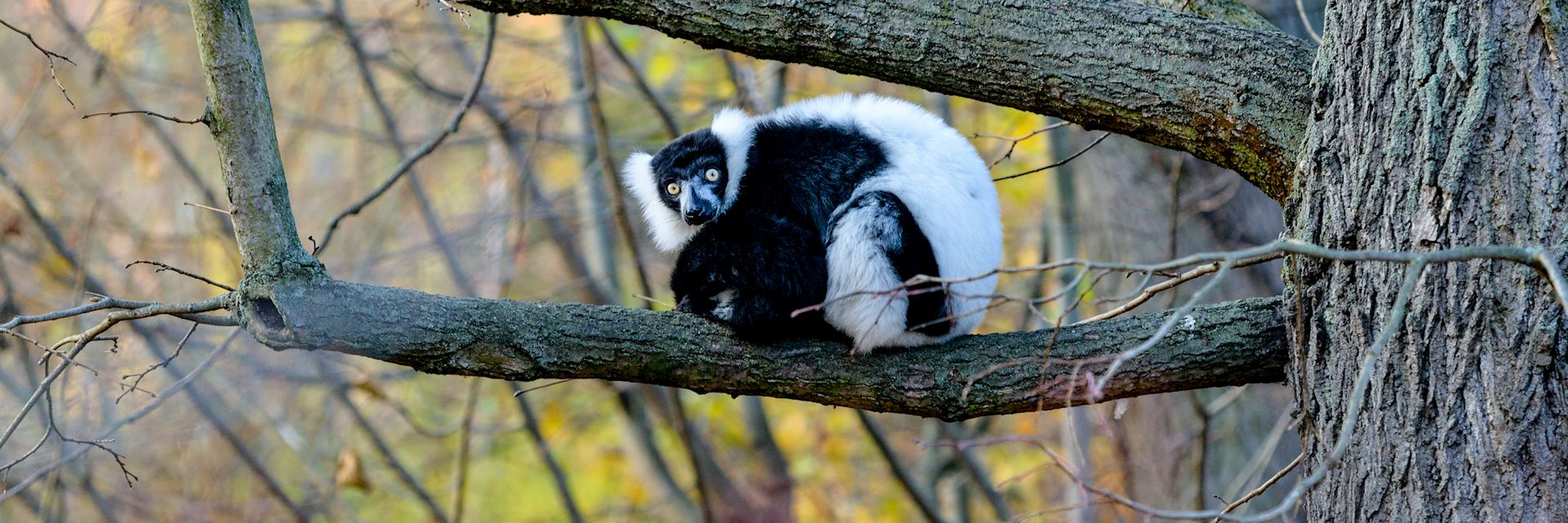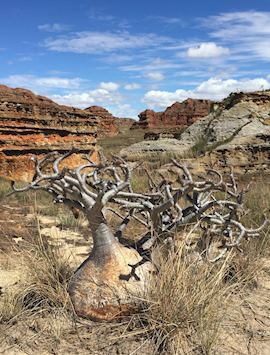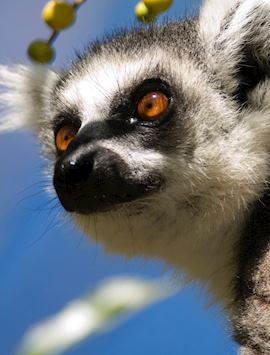Audley specialist Andrew
Madagascar is a place that sparks curiosity; where nature has evolved at its own pace and under its own rules. I arrived with a wildlife tick-list as long as my arm, unsure where to begin or what to expect. I’d imagined an island covered in forests teeming with a cornucopia of animals, but in reality just pockets of forest remain, and seeking wildlife takes patience and practice.
Trudging through the trees with my guide, I soon learned to use my ears as well as my eyes, and while I admired the psychedelic skins of chameleons and vibrant plumage of couas, it was hearing the haunting cry of the indri that most got my heart racing.
Encountering Madagascar’s wildlife

All wildlife-viewing in Madagascar (with the exception of whale-watching trips) is on foot with a professional guide, following trails through the country’s parks and reserves.
While in some cases you’re able to get incredibly close to the wildlife, particularly insects and reptiles, other encounters are from a distance as many lemur and bird species prefer to stay high in the trees. I found having a pair of binoculars and a camera with a good zoom invaluable.
Night walks are particularly exciting in Madagascar, as so many of its wildlife species are nocturnal. You head out with a guide and a flashlight or head torch, walking usually around the outskirts of the park as you look for the glint of a mouse lemur’s eyes or the whitish skin of a chameleon in the foliage.
Routes to take

The type of wildlife you encounter in Madagascar depends on the route you take and places you visit. If you’re visiting for the first time and want to experience a cross-section of Madagascar’s different climates and habitats, I suggest following our southern national parks itinerary, which gives you a good chance of seeing indri, sifaka and ring-tailed lemurs, as well as giraffe-necked weevils, comet moths and a host of birdlife, especially in southwestern parks such as Ranomafana.
If you’re most interested in fossa, our rivers and wildlife of western Madagascar itinerary includes a visit to Kirindy Reserve, where you have the best chance of seeing them. Our luxury Madagascar tour is also a good option, taking you from northwest to southeast so you may see several different lemur species, from Coquerel’s sifakas in Anjajavy Private Nature Reserve to Verreaux’s sifakas in the far south’s spiny forests. It also includes a stay on Île Sainte-Marie, where you have the opportunity to go whale watching.
Wildlife to look out for in Madagascar, and where to find it
Lemurs

Madagascar is the only place in the world where lemurs are found in the wild; the island’s lack of predators and its isolation from the rest of the world has ensured they thrive. Over time, they’ve adapted to the country’s different habitats, evolving into many different subspecies ranging from the tiny pygmy mouse lemur to the toddler-sized indri.
Some of my fondest memories from my travels in Madagascar were thanks to lemur encounters, whether it was hearing the whale-like cry of an indri high up in the trees, spotting the illuminated eyes of mouse lemurs on a night walk or sharing a barbecue with some opportunistic ringtail lemurs looking for scraps.
Over 30 lemur species have been recorded across Madagascar; some are easier to find than others, but your guides will know the best places to look.
Indris

With their upright posture and short tail, indris bear the most resemblance to humans. This may be why they’re revered as sacred animals by many Malagasy, featuring in local legends. The largest of all lemurs, they can grow up to 120 cm (3.9 ft) with their legs fully extended.
It was their loud, distinctive calls made from the treetops that I remember most. Standing directly beneath them with my guide, we listened in stunned silence. It started with a high pitch that lowered over the course of several seconds, like a cross between a whale and a police siren.
Indris inhabit the montane forests of Madagascar’s eastern coast. Andasibe National Park, inland from the east coast, is the best place to see them. Two indri troops here have been habituated to humans, so you can get close-up views and some excellent photographs.
Sifakas

Part of the indri family, sifakas are found throughout Madagascar. Like indris, they also have long hind legs, which they use to bound across the ground — I found it quite comical to see groups of them hopping like kangaroos as they crossed an opening in the forest, their arms raised to keep their balance.
Various subspecies have adapted to live in different habitats around Madagascar, including the commonly seen Verreaux’s sifaka, the white-and-brown-coated Coquerel’s sifaka, and the diademed sifaka, which, I think, is the most attractive with its orange, silver, white, gold and black coat.
Verreaux’s sifakas are spread across the eastern rainforests and dry deciduous and spiny forests in the south and west. Diademed sifakas are only found in the eastern rainforests — Andasibe is one of the best places to look. Coquerel’s sifakas are easy to spot in the dry northwest of the island. I saw them while staying in Anjajavy Private Nature Reserve on the northwest coast.
Aye-aye

A nocturnal species, the aye-aye is one of the more bizarre creatures you’ll encounter in Madagascar. Aye-ayes look like a cross between a bat and a squirrel and feature an exceptionally long middle finger, used for scooping out insects from tree bark.
Ring-tailed lemurs

Instantly familiar with their long black and white tail, ring-tailed lemurs are the easiest lemur to see up close as they spend the most time on the ground. They’re really sociable creatures — all I had to do was stand still and they chased each other around my feet. They make a cat-like mewing call, and in August and September you can see mothers with young clinging to their stomachs.
Ring-tailed lemurs are mostly found in the south of the island — Ifotaka Community Forest is a good place to track them. Anja Community Reserve, near the city of Ambalavao in the southern Central Highlands, also has strong populations.
Mouse lemurs

The tiniest but most abundant of all lemurs, mouse lemurs look more like rodents than primates. A night creature, their huge eyes reflect the light of your guide’s flashlight as they hide in the undergrowth.
There are several subspecies, and grey mouse lemurs live in the dry deciduous and spiny forests in the south and west of Madagascar. Brown mouse lemurs prefer the rainforests in the east, and golden brown mouse lemurs only inhabit the northwest. I saw pygmy mouse lemurs on night walks in Andasibe. They’re also found in Kirindy Reserve in the west, showing their adaptability.
Fossa

Madagascar’s largest mammalian carnivore, the fossa is around the size of a small dog or a large cat and has similarities to both in terms of appearance. Over half of their diet consists of lemurs and they can sometimes be found rummaging through bins for scraps, particularly in Kirindy Reserve.
Chameleons

I’d put chameleons almost on a par with lemurs in terms of their appeal. Around half of all chameleon species are endemic, and they’ve evolved into a wide range of sizes from the 60 cm (24 inch) Oustalet’s and Parson’s chameleons to the minuscule pygmy stump-tailed chameleon, which is no longer than a fingernail at 35 mm (1.4 inches) in length.
I was surprised to learn that chameleons change their hue to show their emotions and communicate rather than for camouflage. In Anja Community Reserve, my guide demonstrated the incredible length of a chameleon’s tongue by placing a cricket on the end of a stick and holding it out — the tongue shot out in the blink of an eye, accurately capturing its prey.
You can find species in most parts of Madagascar. While they’re diurnal, you have more chance of seeing them at night, when they turn almost white.
Birdlife in Madagascar

As you walk through Madagascar’s forests, there’s barely a moment when you can’t hear the sound of birdsong rising from the trees. Of the island’s 285+ bird species, just over 100 are endemic.
Couas

There are nine species in the coua genus, part of the cuckoo family. All have featherless blue skin around their eyes and long, broad tails, but otherwise they vary in appearance. I liked the blue coua with its bluish-indigo plumage, and the crested coua, which has a Mohican-like crest that gives it the look of a punk star.
Three species (red-fronted, red-breasted and blue) predominantly occur in the eastern rainforests, while six (giant, Verreaux’s, Coquerel’s, running, red-capped and crested) generally prefer the dry deciduous and spiny forests in the south and west of the island.
Vangas
Like Darwin’s finches, the 20+ species of the vanga genus have evolved differently in terms of size, beak shape, plumage and foraging techniques depending on their diet and environment.
My guides pointed out several vanga species during my travels and I was amazed at how different they looked — you wouldn’t know they were related at all.

Hook-billed vangas have large black beaks with a hook to help them eat larger prey such as insects and reptiles; sickle-billed vangas have long, curved beaks for accessing holes and cracks in trees; Pollen’s vangas have laterally compressed beaks for ripping through bark; while Chabert’s vangas are lightly built so they can catch insects on the wing.
The different species are spread out across the island. Some prefer the west’s dry deciduous forests, others the rainforests of the east, while several have been discovered in the thorn scrub habitats of the southwest like Isalo National Park.
Madagascar red owls
Part of the barn owl family, the Madagascar red owl has a similar appearance and screeching call, but is slightly smaller with reddish-orange plumage. Another species under pressure from habitat loss, it’s classed as ‘vulnerable’, although this is an improvement on its former ‘endangered’ classification. The owls are predominantly nocturnal so can be tricky to spot.

They mostly stick to the humid evergreen forest in the east and north of Madagascar, places like Amber Mountain National Park. At night they hunt in fairly open areas in or on the edge of primary forest. Heading out on a night walk with a guide gives you the best chance of seeing or hearing one.
Insects to spot in Madagascar
The huge number and diversity of Madagascar’s insects is difficult to grasp, with over 100,000 different species estimated to creep, crawl and fly across the island. There were a few species that particularly stood out for me during my travels:
Giraffe weevils

One of the most familiar of Madagascar’s insect species due to the male’s distinctively long ‘neck’, the giraffe weevil was high on my wildlife tick list. Endemic to Madagascar, it’s all black except for a red covering over the wings. The long, thin neck has evolved to aid males in fighting and building nests for the females to lay their eggs.
You can find giraffe weevils in the rainforests of Ranomafana National Park in the east, and occasionally in Andasibe.
Flatid leaf bugs

This was one of the most bizarre-looking creatures I’ve ever seen. While the adults are flat and pink like flower petals, the nymphs ‘grow’ a white substance that makes them resemble bits of fluff or wispy feathers. The substance protects them from predators, which are left with just the white exterior as the bug escapes.
They mostly reside in the island’s western forests, although I encountered them at Anja Community Reserve. My guide lifted up a rock and a mass of them scattered around; a sight I definitely wasn’t expecting.
Comet moths

Moths are quite a niche species to be excited about, but they started to fascinate me, coming in all shapes, sizes and hues. By far the most impressive I encountered was the comet moth. This isn’t your average moth species; it has a huge wing span of around 20 cm (8 inches) and a tail span of 15 cm (6 inches). The wings are yellow with brown markings and eye-like patterns, but it’s the moth’s streamer-like tail that gives it presence.
Largely nocturnal, comet moths are endemic to Madagascar’s eastern rainforests. While staying in Ranomafana I walked out of my lodge early one morning to find around ten of them resting on the surrounding foliage.
Humpback whales

If you’re visiting between June and October, whale watching is an option off Madagascar’s east coast. Humpback whales migrate here from Antarctica to breed and calve in the warm waters. They can often be spotted breaching the waves from the shoreline, or you can get a closer look by heading out on a boat trip from Île Sainte-Marie (an island off Madagascar’s northeast coast).
Aside from the waters off Île Sainte-Marie, I also recommend Masoala National Park in the northeast, where you may glimpse a whale’s tail or a whale spouting water while strolling along the deserted beaches of Antongil Bay.
Start planning your wildlife trip to Madagascar
Start thinking about your experience. These itineraries are simply suggestions for how you could enjoy some of the same experiences as our specialists. They’re just for inspiration, because your trip will be created around your particular tastes.
View All Tours in Madagascar




